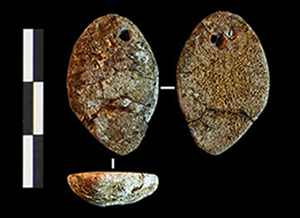Crossref Citations
This article has been cited by the following publications. This list is generated based on data provided by
Crossref.
Piličiauskas, Gytis
Simčenka, Edvardas
Lidén, Kerstin
Kozakaitė, Justina
Miliauskienė, Žydrūnė
Piličiauskienė, Giedrė
Kooijman, Ellen
Šinkūnas, Petras
and
Robson, Harry K.
2022.
Strontium isotope analysis reveals prehistoric mobility patterns in the southeastern Baltic area.
Archaeological and Anthropological Sciences,
Vol. 14,
Issue. 4,
Ahola, Marja
Holmqvist, Elisabeth
and
Pesonen, Petro
2022.
Materialising the Social Relationships of Hunter-Gatherers: Archaeological and Geochemical Analyses of 4th Millennium BC ‘Slate Ring Ornaments’ from Finland.
Journal of Archaeological Method and Theory,
Vol. 29,
Issue. 4,
p.
1259.
Jørgensen, Erlend Kirkeng
2023.
Technological organization and initial production stages of a maritime slate tradition: insights from the first investigated Stone Age slate source in Arctic Europe (the Djupvik slate formation, Norway).
Acta Borealia,
Vol. 40,
Issue. 1,
p.
46.
Ryazantsev, Pavel
Tarasov, Aleksey
and
Potakhin, Maksim
2023.
Archaeological prospection of a prehistoric lithic workshop site using ground penetrating radar with a high‐frequency antenna unit.
Archaeological Prospection,
Vol. 30,
Issue. 3,
p.
341.
Karmanov, Viktor N.
2023.
THE GARINO TRADITION OF BIFACIAL FLINT KNAPPING AND THE PROBLEM OF SEARCHING FOR ITS ORIGINS.
Rossiiskaia arkheologiia,
p.
20.
Bochkarev, Vadim Sergeevich
and
Poliakov, Andrei Vladimirovich
2024.
Encyclopedia of Archaeology (Second Edition).
p.
1.
Petrović, Anđa
Macāne, Aija
Strautnieks, Ivars
Kalniņa, Laimdota
Holmqvist, Elisabeth
Hunter, Emily M.
Pomstra, Diederik
Goodchild, Helen
Villén, Ana Harto
Zagorska, Ilga
Edmonds, Mark
Nordqvist, Kerkko
and
Little, Aimée
2024.
Stone axes throw new light on Baltic stone age mortuary rites.
Scientific Reports,
Vol. 14,
Issue. 1,
Nordqvist, Kerkko
2024.
Encyclopedia of Archaeology (Second Edition).
p.
672.
Alenius, Teija Helena
Marquer, Laurent
and
Nordqvist, Kerkko
2024.
Exploring local and regional vegetation compositional changes during the Neolithic (5th–3rd millennium BC): A case study on the forager impact on vegetation in north-east Europe.
The Holocene,
Vol. 34,
Issue. 9,
p.
1304.
Eckelmann, Rebekka
Arppe, Laura
Tarasov, Alexey
Pospieszny, Łukasz
Ackerman, Lukáš
Heyd, Volker
Gerasimov, Dmitry
Moiseyev, Vyacheslav
Fairbanks, Vanessa
Hyland, Corrie
and
Mannermaa, Kristiina
2025.
Mobility and community at Mesolithic Lake Onega, Karelia, north-west Russia: insights from strontium isotope analysis.
Archaeological and Anthropological Sciences,
Vol. 17,
Issue. 1,
